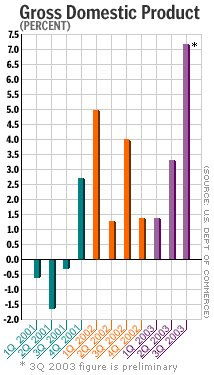NEW YORK (CNN/Money) -
As strong as third-quarter GDP growth was, it would have been even more blistering if businesses hadn't cut inventory by billions of dollars -- and some economists believe the fourth-quarter growth rate will be stronger than expected as businesses scramble to restock their shelves.
But other economists worry weak pricing power and improvements in inventory technology will keep a lid on warehouse stocking for a while to come.

The Commerce Department said Thursday that businesses were on a pace in the third quarter to slash inventories by $35.8 billion for the year, accelerating the second quarter's $17.6 billion annual rate.
Slamming the brakes on inventories cut nearly 0.7 percentage point from the third quarter's total gross domestic product (GDP) growth, which clocked in at a net annual rate of 7.2 percent.
But inventories can't fall forever -- once shelves are empty, they're empty -- and many economists believe businesses simply can't operate effectively with empty warehouses.
"Inventories are at rock-bottom levels -- even if economic growth slows in the fourth quarter, those inventories will have to be rebuilt, otherwise businesses risk losing business," said former Federal Reserve economist Wayne Ayers, now chief economist at Fleet Boston Financial.
Stockpiles not growing yet
Still, such rebuilding will likely be cautious, at best -- and it doesn't appear to have begun yet.
For one thing, many goods producers are still having a hard time raising prices, but are paying more for the commodities they use to make stuff. Under such conditions, they've got little incentive to produce a bunch of goods with costly raw materials unless it's absolutely necessary.
| Related stories
|

|
|
|
|
"Uncertainty about the pricing environment will keep inventory investment more disappointing than some other economists expect," said David Resler, chief economist at Nomura Securities.
Friday's report from Chicago-region purchasing managers could be a snapshot of this effect in action. The group's "inventories" index plunged in October, posting the biggest one-month decline since April 1977. Meanwhile, the "prices paid" index, a measure of raw material costs, jumped to 61.5, the highest level since 62.8 in March.
What's more, many more companies -- including Wal-Mart, the world's biggest retailer -- are using technological advancements such as "radio frequency identification (RFID)," wireless tags that help track goods, to keep a tight lid on inventories.
The recent decision by the U.S. Department of Defense (DOD) to require its suppliers to move to RFID technology by 2005 will only make the process move faster, according to Mark Roberti, editor of RFID Journal, a Web site that tracks the spread of RFID technology.
"The U.S. military has the largest supply chain on the planet. It purchases military products, clothes, food, drugs and lots of other products," Roberti wrote in a recent editorial. "The DOD will push RFID technology deep into the manufacturing sector."
The change in the change
Still, what's most important to GDP growth is the change in inventories, not the actual level of inventories. As long as companies just stop cutting inventories so much, it will give GDP a boost, as it did in the first quarter of 2002.
In that quarter, inventories shrank at a $30 billion annual pace, but that number was so much friendlier than the fourth quarter of 2001, when inventories shrank at a whopping $98 billion pace, that the relative improvement boosted GDP by 2.6 percentage points -- more than half of that quarter's total GDP gain.
Morgan Stanley chief U.S. economist Richard Berner estimates that simply leaving inventories alone in the fourth quarter could boost GDP by as much as 1.2 percentage points.
Citigroup senior economist Steven Weiting is expecting a similar impact, of about 1 percentage point, which could push total GDP growth above the Wall Street consensus estimate, according to the latest Blue Chip forecast, of 3.7 percent.
"We expect a drop in inventories in the fourth quarter," but at only about a $5 billion pace as opposed to the third quarter's $36 billion pace, Weiting said. "That's a big difference. What's important is the change in the change."

|

